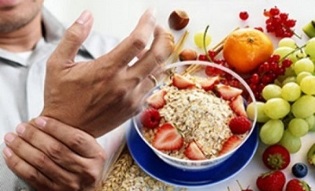Proper nutrition is the basis of effective treatment for osteoarthritis of the knee joint. Anyone interested in improving their health should understand what diet is needed for osteoarthritis of the knee joint. Basic principles, allowed and forbidden foods, sample menu - the main issues that need to be considered in addition.
Dietary requirements for osteoarthritis

The main purpose of a diet for knee joint disease is to lose weight and get the right amount of nutrients that have a positive effect on cartilage tissue and symptoms. Proper nutrition should be observed until the end of life.
General principles of osteoarthritis diet:
- Fractional nutrition needs. It is recommended to eat in small portions up to five times a day. Fractional nutrition prevents overeating and therefore better weight.
- The maximum amount of calories per day is 3500 kcal. Such calorie content is allowed by an active lifestyle and serious physical labor.
- Dinner is required a few hours before bedtime.
- It is recommended to constantly monitor the weight.
- The diet contains healthy foods with the necessary components for the knee joints. Potentially harmful foods have been removed from the menu.
- Meals require appropriate heat treatment. The benefits of food depend on it.
- Eliminate very hot and cold foods. It is recommended to eat hot dishes.
- You need to chew carefully and slowly. Following this rule will prevent overeating.
- It is recommended to drink one and a half liters a day. The emphasis is on clean water.
The diet is prepared under the supervision of a doctor, taking into account the patient's health status when making recommendations to doctors. Experts recommend that products that help you get the right amount of food be included in the menu. Body support aims to prevent osteoarthritis and relieve symptoms associated with inflammatory processes.
Basic Nutrients
Osteoarthritis of the knee requires minerals and vitamins, so this aspect is important when planning a meal.
.jpg)
Vitamin C is one of the most important. Vitamin C forms connective tissue, restores cartilage of the knee joint. Antioxidant properties protect cartilage tissue of the knees from free radicals. Doctors say that women need less vitamin C every day and more for men. Vitamin C also helps to improve the immune system, which helps the body fight inflammation of the knee joints on its own.
Boron promotes bone renewal. Boron and magnesium help to fully absorb the calcium needed for the knee joints. As a result, boron and magnesium, as well as calcium are required in the preparation of the diet. The three components that work together are required not only for treatment but also for prevention.
Pantothenic acid improves cell health of the knee joint. A useful component is found in beef and pork liver, nuts, mushrooms, green peas. The amount of the substance is determined by the severity of symptoms.
Include omega-3 fatty acids in your diet. The substances eliminate the pain syndrome, inflammation. A stable supply of fatty acids is required for a pronounced therapeutic effect.
Prohibited Products
Many people wonder what not to eat with osteoarthritis of the knee joint. Some foods contain potentially dangerous substances. If eating increases the risk of weight gain, it is also recommended to skip it.
The following foods have been excluded from the diet:
- Fatty meat products. Such products cause weight gain, impair the condition of the knee joints, adversely affect motor function and increase symptoms.
- Vegetables: white cabbage, bell pepper, tomato. These vegetables contain dangerous components for the cartilage tissue of the knee joint. For example, the use of tomatoes for knee arthrosis is minimized, despite the fact that fresh vegetables contain nutrients.
- Acidic fruits and berries. Such fruits lead to the accumulation of mineral salts, which are dangerous for the joints.
- Flour products, sweets. Such foods contain simple carbohydrates that threaten to gain extra weight.
- Coffee. Excessive consumption of alcohol leads to a decrease in calcium salts in the body. This results in joint problems. Calcium deposits help maintain healthy knee joints.
- Alcohol. There is a violation of metabolic processes. No more nutrients are absorbed.
- Semi-finished products, street fast food products.
- Mayonnaise.
- Oily refined oils.
- Salt. Doctors advise to look carefully at the amount of salt. Excessive salt intake threatens the salt deposits, the deterioration of the knee joints.
Doctors also prohibit additional smoking, because nicotine leads to narrowing of blood vessels, resulting in disruption of metabolic processes. Smoking reduces the effectiveness of any treatment.
It is forbidden to fast during healing. The body needs food. The use of diuretics and laxatives is prohibited. Such drugs disrupt metabolic processes and contribute to the loss of nutrients needed for the knee joints.
Useful products

The diet contains nutrients that are beneficial for osteoarthritis of the knee joint. Healthy foods provide the nutrients needed to improve knee health.
- Low-fat poultry, meat, fish. Meat and fish dishes should be natural. Soups based on meat broths are consumed regularly, but preference is still given to vegetable first courses.
- Fermented dairy products. The proteins provided improve the cartilage tissue of the knee joints. The maximum fat content of dairy products should be 3, 2 percent. The menu includes fermented dairy products with high calcium content.
- Eggs. You are allowed to eat up to three eggs a day. Many eggs disrupt metabolic processes, so there is a risk of adverse effects on the knee joints.
- Natural meat jelly. The diet contains collagen and chondroitin, which are needed to improve the condition of the knee cartilage.
- Nuts. Vitamin E intake improves metabolic processes, stimulates the flow of beneficial compounds to the knee joints.
- Grain. The most useful millet, rice, buckwheat, hard pasta. For standard times, cooked grains provide nutrients and complex carbohydrates to support the body.
- Fresh vegetables and fruits. These foods contain foods that support the body in the fight against knee inflammation.
- Still mineral water, herbs and green tea. The diet also includes freshly made fruit and vegetable juices previously diluted with water. Healthy drinks help to get vitamins and maintain the body's water balance.
Knee arthrosis menus contain healthy foods to ensure optimal nutrition.
Sample menu for a day with osteoarthritis
If the menus are right, the diet is varied and nutritious.
For a glass of clean water before breakfast. The fluid improves metabolic processes and cleanses the intestines.
Breakfast
Drink fruit or vegetable juice first. After 20 minutes, it is recommended to eat porridge with a piece of butter. If you want, they plan cheesecakes with natural honey, cereal cookies, sandwiches with hard cheese, boiled eggs, vegetable salad for breakfast. For green or herbal tea after breakfast.
Lunch
Fresh fruit or dried fruit is eaten for lunch. In osteoarthritis, food intake is mandatory in a diet aimed at improving health.
Lunch
Planning a vegetable or meat soup for dinner. For the latter, cutlets, baked chops, baked and boiled fish are ideal. It is advisable to pay attention to the presence of vegetable stew, mashed potatoes or baked potatoes, cereals. Rye bread will help to get additional substances aimed at improving metabolic processes.
Afternoon snack
In the afternoon, they eat fresh sweet fruit for a snack and drink a cup of dried fruit compote with dry biscuits.
Food
Nutritionists recommend a light meal to prevent weight gain. Recommended dishes are vegetable salad, cottage cheese casserole with soothing herbal tea.
When planning a proper diet for osteoarthritis of the knee joint, attention is paid to the optimal calorie intake, the intake of useful components.























